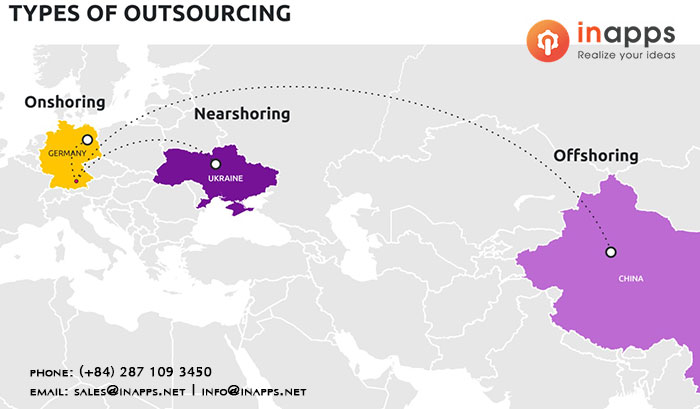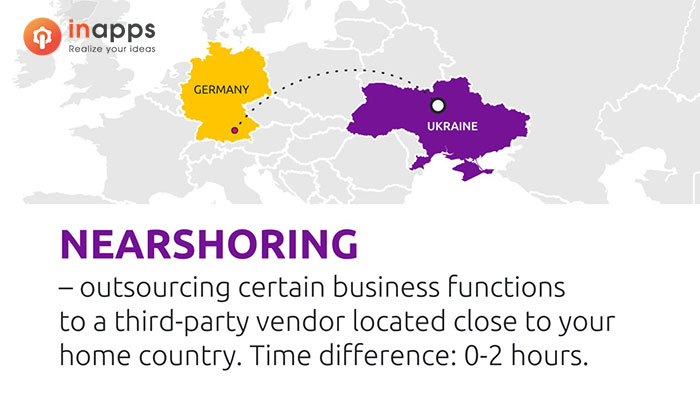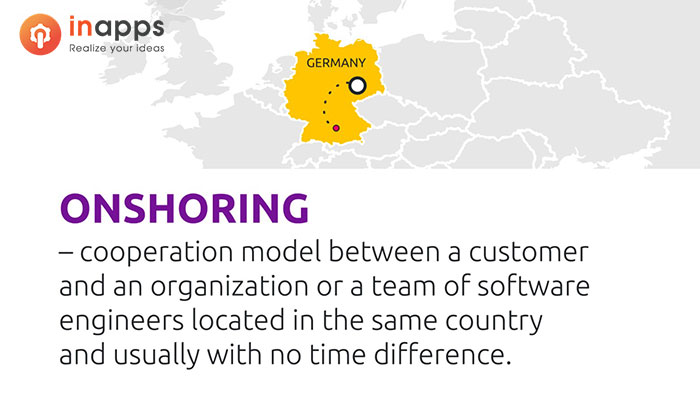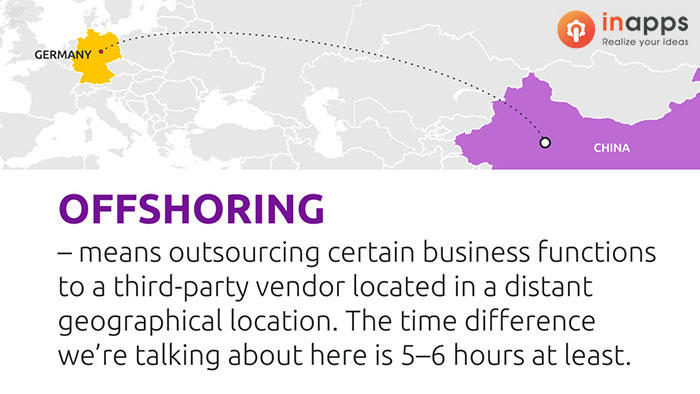- Home
- >
- Offshore News
- >
- Onshore vs Nearshore vs Offshore Outsourcing Models (+Case studies)
The world of technology-driven businesses is so fast-paced and dynamic that sometimes you just can’t achieve workable and scalable growth with an in-house team. This often means that the only sustainable way to get the job done is to outsource.
In this article, we’ll discuss the following three modes of outsourcing: onshore vs nearshore vs offshore, covering the specifics of each one to help you choose the model that best fits your business needs.

Distinguish Onshore vs Offshore vs Nearshore
Key Summary
- Overview: The article by InApps Technology explains the distinctions between onshore, nearshore, and offshore software development models, detailing their definitions, benefits, challenges, and suitability for different business needs, with a focus on cost, proximity, and collaboration.
- Definitions:
- Onshore: Outsourcing software development to a company within the same country as the client.
- Example: A U.S. company hiring a developer in another U.S. state.
- Nearshore: Outsourcing to a company in a nearby country, typically in a similar time zone.
- Example: A U.S. company hiring developers in Mexico or Canada.
- Offshore: Outsourcing to a company in a distant country, often with significant time zone and cultural differences.
- Example: A U.S. company hiring developers in Vietnam or India.
- Onshore: Outsourcing software development to a company within the same country as the client.
- Key Differences:
- 1. Location and Proximity:
- Onshore: Same country, minimal geographic distance, shared legal and cultural frameworks.
- Nearshore: Neighboring countries, close proximity, similar time zones (0-2 hours difference).
- Offshore: Farther countries, significant distance, larger time zone gaps (6-12 hours).
- 2. Cost:
- Onshore: Highest cost due to local labor rates (e.g., $80-$150/hour in the U.S.).
- Nearshore: Moderate cost, lower than onshore but higher than offshore (e.g., $40-$80/hour in Mexico).
- Offshore: Most cost-effective, with rates like $20-$50/hour in Vietnam, saving 20-40% compared to onshore.
- 3. Time Zone and Collaboration:
- Onshore: Same or similar time zones, enabling real-time communication and collaboration.
- Nearshore: Minimal time zone differences, allowing significant overlap in working hours.
- Offshore: Large time zone gaps (e.g., Vietnam GMT+7 vs. U.S. EST) may delay communication, requiring asynchronous workflows.
- 4. Cultural and Language Alignment:
- Onshore: Shared language (e.g., English) and cultural norms, minimizing misunderstandings.
- Nearshore: Similar cultures and strong English proficiency, with minor regional differences.
- Offshore: Potential cultural and language barriers, though mitigated by English-trained teams in hubs like Vietnam.
- 5. Quality and Expertise:
- Onshore: High-quality talent, but limited availability and higher costs may restrict access.
- Nearshore: Comparable expertise to onshore, with growing tech hubs (e.g., Latin America).
- Offshore: Access to large talent pools (e.g., Vietnam’s 200,000+ IT professionals), high expertise at lower costs, though quality varies by provider.
- 1. Location and Proximity:
- Benefits:
- Onshore:
- Seamless communication due to shared language and culture.
- Easier compliance with local regulations and data privacy laws (e.g., GDPR, HIPAA).
- Faster collaboration with real-time meetings and site visits.
- Nearshore:
- Cost savings compared to onshore while maintaining close collaboration.
- Similar time zones enable Agile workflows and quick responses.
- Cultural alignment reduces miscommunication risks.
- Offshore:
- Significant cost savings ($20-$50/hour in Vietnam vs. $80-$150/hour in U.S./EU).
- Access to diverse, skilled talent pools for specialized tech (e.g., AI, blockchain).
- 24/7 productivity possible with time zone differences for continuous development.
- Onshore:
- Challenges:
- Onshore:
- High costs limit scalability for startups or SMEs.
- Talent shortages in competitive tech markets (e.g., Silicon Valley).
- Nearshore:
- Higher costs than offshore, potentially straining budgets.
- Limited talent pools compared to offshore hubs like India or Vietnam.
- Offshore:
- Time zone differences complicate real-time collaboration.
- Cultural/language barriers may require additional coordination.
- Potential risks with data security or intellectual property if vendors lack robust protocols.
- Onshore:
- Use Cases:
- Onshore: Ideal for projects requiring strict regulatory compliance (e.g., healthcare, finance) or close collaboration (e.g., sensitive government contracts).
- Nearshore: Suited for Agile projects needing real-time interaction and moderate cost savings (e.g., web/mobile app development for North American clients in Latin America).
- Offshore: Best for cost-sensitive projects, large-scale development, or specialized tech needs (e.g., AI-driven apps, blockchain solutions in Vietnam).
- InApps Technology’s Role:
- Specializes in offshore software development in Vietnam, offering expertise in mobile, web, AI, and blockchain solutions.
- Leverages Vietnam’s 200,000+ IT professionals, providing cost-effective rates ($20-$50/hour) with high-quality output.
- Supports Agile workflows with tools like Jira, Slack, and Zoom for transparent collaboration, mitigating offshore challenges like time zones (GMT+7).
- Recommendations:
- Choose Onshore for projects needing tight regulatory control or real-time collaboration, despite higher costs.
- Opt for Nearshore for a balance of cost savings and close coordination, ideal for Agile teams in similar time zones.
- Select Offshore for maximum cost efficiency and access to large talent pools, ensuring vendors have strong English skills and security measures.
- Partner with InApps Technology for expert offshore development in Vietnam, leveraging skilled developers for cost-effective, high-quality solutions tailored to your needs.
1. What’s The Differences Between Offshoring, Nearshoring, and Onshoring?
Outsourcing means delegating certain business functions or projects to a third-party company located anywhere globally – two blocks away from your HQ or on another continent. A Munich-based digital agency partnering with a software development company located in Hamburg, where the latter developed the former’s website, would be an example of outsourcing.
There are many reasons why companies may want to outsource. Lower costs are often cited as the most significant motivating factor, though that’s not the whole story. Lack of qualified local staff, access to a global talent pool, the ability to scale fast, and shorter delivery time. The fact that there’s no need to spend time and money on recruitment are all pull factors drawing companies large and small alike into the world of outsourcing.
1.1 Offshoring Outsourcing
Offshoring outsourcing means outsourcing certain business functions to a third-party vendor located in a distant geographical location. The time difference we’re talking about here is 5–6 hours at least. If a Munich-based digital marketing agency partnered with a Chinese software development company, we would call offshoring.
Common offshoring destinations for both the US and Western European countries include India, the Philippines, and China. Additionally, US-based companies that outsource to Eastern European countries such as Romania, Poland, or Ukraine also serve as examples of offshoring. Get outsourcing rates in Eastern Europe, Asia, Latin America, and Africa, and tips on choosing the country for offshore development.
1.2 What does nearshoring mean?
Nearshoring means outsourcing certain business functions to a third-party vendor located much closer to your home — usually in the same time zone or one within a couple of hours of it. A Munich digital agency partnering with a Ukrainian development company is an example of nearshoring. US companies commonly outsource to Mexico and many other Central and South American destinations, including Argentina, Brazil, and El Salvador.
In Europe, nearshoring relationships often form between Western European and Eastern European companies. Common nearshoring destinations include Ukraine, Poland, Hungary, Romania, Bulgaria, and the Baltic states.

What does nearshoring mean?
1.3 Onshoring Definition
Onshoring is a cooperation model between a customer and an organization or a team of software engineers located in the same country usually with no time difference. This solution is usually more expensive than offshoring and nearshoring; however, it has several advantages, precisely the quickest possible results, and improved communication.

Onshoring Cooperation Model
Onshore Vs. Nearshore Vs. Offshore have their strong and weak points. Let’s take a closer look at the pros and cons of each of them to help you figure out which model will work best for your business.
2. Pros and cons of Onshore vs Nearshore vs Offshore
2.1 Offshore Outsourcing Pros and Cons
Offshoring works best for:
- Companies that need round-the-clock tech or customer support
- Large online platforms that need to run constant updates or maintenance work and don’t want to inconvenience their users with downtime
The Benefits of Offshoring:
- Reduced expenses due to lower production costs, salaries, cost of living of personnel, etc.
- Thanks to the time difference between the in-house and offshore teams, an uninterrupted workflow was achieved.
- Access to a global talent pool makes finding professionals with the skills you need a lot easier than trying to find them at home.
The Disadvantages of Offshoring:
- Significant time difference.
- Communication can get tricky if you’re ordinarily asleep while the offshore team is working.
- Different work habits stemming from different cultural norms and attitudes about work can get in the way of your established business processes and require adjustments on both sides.
- Language barriers can cause misunderstandings and wasted effort unless you and the company you work with have at least one language in common.
- Long distances between you and the offshore vendor could make business trips a costly and cumbersome experience, especially if you need to regularly visit your partner’s offices.
2.2 Nearshoring Pros and Cons
The Benefits of Nearshoring
- Having a small or non-existent time difference means neither you nor your nearshore partner will have to work overtime or at night to synchronize meetings or stay in touch.
- Shorter distances between you and your vendor make business trips easy, accessible, and more affordable.
- Sharing a similar cultural background with your partner eliminates the need to change your work habits.
- Lower average salaries in nearshore countries can make this option preferable to finding personnel in your home country.
The disadvantages of nearshoring
- There are fewer options since you’re limited in selecting providers located in neighboring countries.
- More expensive than offshoring if your business operates in Europe or the US.
2.3 Onshoring Pros and Cons
Onshoring works best for:
- Companies that are seeking constant and smooth communication;
- Organizations that do not want to deal with cultural differences;
The benefits of onshoring:
- Smooth communication since there is no time difference between the in-house team and the extended team;
- Minimum delivery time;
- The possibility to invest in your country;
The disadvantages of onshoring:
- Often more expensive;
- Limited talent pool since you only get to choose talent within the borders of your country.
3. Onshore vs Nearshore vs Offshore Comparison Table
| Aspect | Onshore | Nearshore | Offshore |
|---|---|---|---|
| Location | Same country | Neighboring or nearby countries | Distant countries, often across continents |
| Cost | Highest due to local market rates | Lower than onshore but higher than offshore due to regional differences | Lowest, benefiting from global wage differences |
| Cultural Differences | Minimal, as teams share similar cultural backgrounds | Moderate, generally less than offshore but more than onshore due to regional similarities | Significant, with potential challenges arising from differing cultural norms |
| Language Barriers | Least likely, as teams speak the same language | Low, especially if the countries share a common language or high English proficiency | Can be high, depending on the country’s English proficiency and language differences |
| Time Zone Differences | None | Minimal, allowing for convenient collaboration | Significant, which can complicate real-time communication but offer round-the-clock productivity in some cases |
| Scalability | Limited by local talent availability | Better than onshore due to wider access to regional talent pools | Best, due to a vast global talent pool |
| Communication & Collaboration | Easiest due to geographical proximity and no time difference | Generally easy, especially with modern communication tools, though slightly less so than onshore due to potential slight cultural and time differences | More challenging due to time zone and potential cultural differences, but manageable with proper team management practices. |
| Specific Risks |
|
|
|
4. Choosing the Right Model for Your Business
Understanding the differences between Onshore, Nearshore, and Offshore outsourcing models can empower project managers to make informed choices. Each model offers distinct advantages and challenges, tailored to different project environments and objectives. Here’s a closer look at these models to guide project managers in choosing the right outsourcing models for their businesses.
4.1 Choose Onshore Outsourcing when
Ideal for projects requiring close collaboration, and real-time communication, and when cultural alignment is crucial. However, it’s the most expensive option due to higher local labor costs. Projects that benefit most from onshore outsourcing are those where face-to-face interaction is essential or when working within highly regulated industries.
Case study
MedAssets, Inc., a healthcare improvement company in the United States, faced a challenge: updating their CMS front-end from Silverlight to ASP.NET MVC without disrupting other projects. To achieve this, they engaged with an onshore development team known for their expertise in software development and quality assurance. This collaboration led to the creation of a new front-end system that enhanced daily operations for business users, showcasing the effectiveness of onshore outsourcing for projects requiring specialized skills and seamless team integration.
4.2 Choose Nearshore Outsourcing when
Your project needs a middle ground, providing cost savings over onshore outsourcing while maintaining easier communication and cultural alignment than offshore. It’s particularly beneficial for businesses looking to balance cost with the need for some degree of close collaboration or when managing projects that require frequent visits or oversight.
Case study
Raisin, a German fintech startup, partnered with Codete for nearshore outsourcing to develop a core component for deposit placement optimization and manage several deposit accounts in European banks through a single online system. This project required a dedicated IT team with deep fintech knowledge and an understanding of digital banking security policies. The collaboration successfully met Germany’s stringent data privacy and banking system encryption conditions, showcasing the benefits of nearshore outsourcing in accessing specialized talent and ensuring compliance with EU regulations
4.3 Choose Offshore Outsourcing when
You want the most cost-effective solution, offering significant savings on labor costs. It’s suitable for projects where the work can be done remotely without the need for constant real-time communication. The challenge with offshore outsourcing is managing the time zone differences and ensuring clear communication despite cultural differences. However, it allows for round-the-clock productivity and access to a vast pool of global talents
Case study
In the offshoring case study of the Streaming TV App, the client from the United States collaborated with InApps Technology, an offshoring company based in Vietnam. This partnership aimed to develop a comprehensive streaming TV platform with cloud DVR functionality, addressing challenges such as time zone differences and ensuring effective communication. Utilizing technologies like React and implementing features for enhanced user experience, the project was successfully delivered, demonstrating the benefits and effectiveness of the offshoring model between a US client and a Vietnamese technology partner.
5. Find Your Trusted Offshoring Partner at InApps Technology
Choosing the right outsourcing model is crucial for your business’s growth and efficiency. Each option—onshore vs. nearshore vs. offshore—has its benefits, depending on your needs and goals. Offshore outsourcing, in particular, offers great cost savings and access to a global talent pool, making it an excellent choice for many businesses.
If you’re considering offshore outsourcing, our services at InApps can provide the quality and efficiency you’re looking for. With our expertise, you can achieve your project goals effectively while optimizing costs. Check out our offshore software development services at InApps Offshore Software Development Center and see how we can help your business thrive.
Let’s create the next big thing together!
Coming together is a beginning. Keeping together is progress. Working together is success.





















